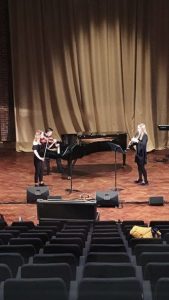Tracing a Trio
 Hannah Shilvock (clarinet/bass clarinet, year 3), Ellie Purvis (violin, year 3), and Adam Rean (piano, year 2) have formed the Woodnote Trio, playing together for their Ensemble performance module this year and performing in different venues around the region as well. We interviewed them to find out what their year has been like.
Hannah Shilvock (clarinet/bass clarinet, year 3), Ellie Purvis (violin, year 3), and Adam Rean (piano, year 2) have formed the Woodnote Trio, playing together for their Ensemble performance module this year and performing in different venues around the region as well. We interviewed them to find out what their year has been like.
The combination of clarinet, violin and piano is unusual. What are the challenges of playing in this formation?
Ellie: Balance is quite tricky.
Adam: They are three such different instruments. I started out too quiet, and eventually found out where I needed to be.
Ellie: If piano is written in my part, I have to think of a level that’s piano for the clarinet. I have to play fortes bigger than before, and I have to work on articulations to make them more apparent or they’re drowned in the clarinet.
Hannah: If our lines are together and I’m breathing and the violin isn’t, that can be a problem.
Ellie: Last year I did violin duets so the breathing question didn’t come up. It makes a difference to how you phrase. We really have to work to get that together.
Adam: I have to be aware of the breathing as well. Initially I thought of myself as a support part, as an accompanist, but then I realised I was an equal partner in a trio, and it was something I had to get used to at the start.
Hannah: When I was in first year, I worked with a pianist who hadn’t accompanied before, and it took a while to get used to breathing – but this group settled quickly as Ellie realised that we had to be together.
Has it been difficult to find repertoire?
Hannah: Yes. For this semester’s work, we emailed Andy Fisher and Ben Oliver to see if they had written, or could write, anything for this combination. Andy’s Concertino was originally written as an ensemble concerto, and he made a trio version specially for us. We did the first performance of the trio arrangement last Friday.
Ellie: My violin teacher suggested that we should try Dream Tracks, by the Australian composer Peter Sculthorpe.
Hannah: We played different repertoire in first semester, which was challenging, but in a classical way – the pieces were written for our instruments and although it was difficult you knew it could be done. In the Concertino’s second movement the bass clarinet part is really high. Usually when the bass clarinet goes into that register it leaps up for just a short section, but here there are sustained melodies in the high register, and I’ve had to work at keeping the sound sweet and lyrical.
Adam: The orchestral reduction to the piano in the Concertino is really difficult as all the lines written for other instruments have been reduced to the piano part.
Ellie: Sculthorpe’s Dream Tracks is very different from the Concertino. It’s about an Australian aboriginal idea that any living creature leaves a trace when it dies.
Hannah: It’s about 18 minutes long and more textural in nature. It doesn’t have distinct melodies and each section blends into each other.
Adam: The aesthetic is minimalist. It’s very static in feel. The two pieces make a good combination, as the jazz influence is very evident in the Fisher and it’s much more energetic.
Ellie: It’s great that for the Fisher we have lots of interpretive freedom, as it hasn’t been recorded and we’re the first to play it in this version.
Adam: Andy said we could do what we want!

